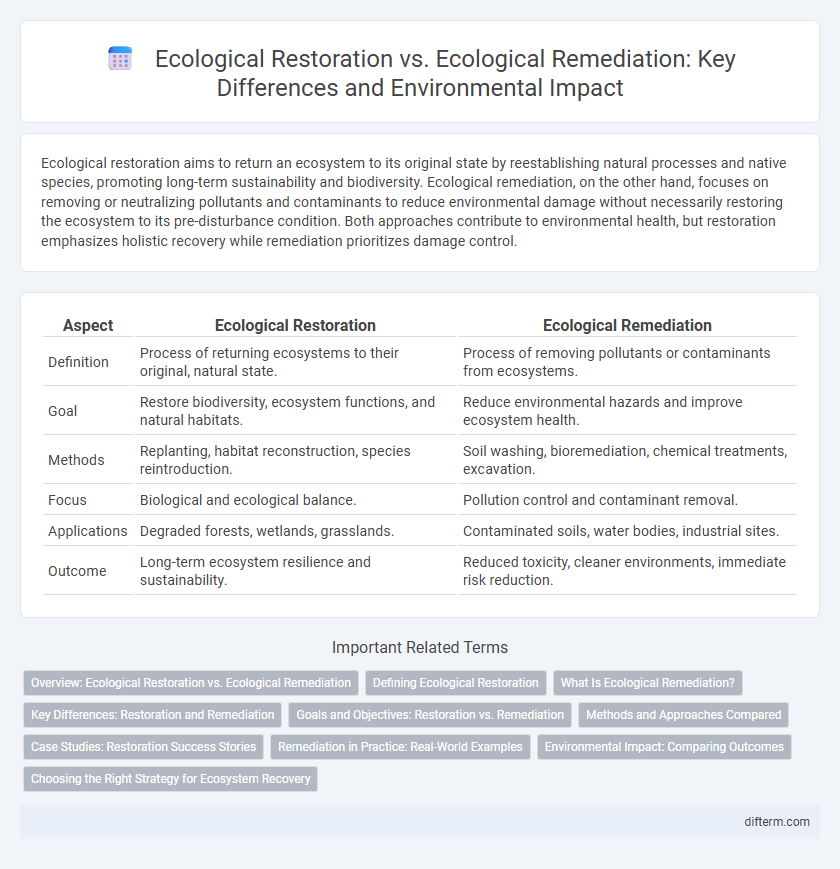Ecological restoration aims to return an ecosystem to its original state by reestablishing natural processes and native species, promoting long-term sustainability and biodiversity. Ecological remediation, on the other hand, focuses on removing or neutralizing pollutants and contaminants to reduce environmental damage without necessarily restoring the ecosystem to its pre-disturbance condition. Both approaches contribute to environmental health, but restoration emphasizes holistic recovery while remediation prioritizes damage control.
Table of Comparison
| Aspect | Ecological Restoration | Ecological Remediation |
|---|---|---|
| Definition | Process of returning ecosystems to their original, natural state. | Process of removing pollutants or contaminants from ecosystems. |
| Goal | Restore biodiversity, ecosystem functions, and natural habitats. | Reduce environmental hazards and improve ecosystem health. |
| Methods | Replanting, habitat reconstruction, species reintroduction. | Soil washing, bioremediation, chemical treatments, excavation. |
| Focus | Biological and ecological balance. | Pollution control and contaminant removal. |
| Applications | Degraded forests, wetlands, grasslands. | Contaminated soils, water bodies, industrial sites. |
| Outcome | Long-term ecosystem resilience and sustainability. | Reduced toxicity, cleaner environments, immediate risk reduction. |
Overview: Ecological Restoration vs. Ecological Remediation
Ecological restoration aims to return ecosystems to their original state by reestablishing native species, natural processes, and habitat functions, often addressing large-scale environmental degradation. Ecological remediation focuses on mitigating environmental damage through contaminant removal, pollution control, and site-specific interventions to reduce ecological risks and restore functionality. Both strategies contribute to biodiversity conservation and ecosystem resilience but differ in scope, with restoration prioritizing holistic recovery and remediation targeting targeted environmental hazards.
Defining Ecological Restoration
Ecological restoration is the process of assisting the recovery and management of ecosystems that have been degraded, damaged, or destroyed, aiming to reestablish their original structure, function, and biodiversity. It involves activities such as reforestation, soil stabilization, and reintroduction of native species to restore natural habitats and ecosystem services. Unlike ecological remediation, which focuses primarily on removing pollutants and mitigating environmental hazards, restoration emphasizes the full recovery of ecological integrity and resilience.
What Is Ecological Remediation?
Ecological remediation involves the process of removing pollutants and contaminants from ecosystems to restore environmental quality and functionality. It targets the cleanup of soil, water, and air affected by industrial activities, chemical spills, or waste disposal, aiming to reduce toxicity and promote the recovery of natural habitats. This approach focuses on reversing damage through physical, chemical, or biological treatments that mitigate environmental hazards and protect biodiversity.
Key Differences: Restoration and Remediation
Ecological restoration aims to return ecosystems to their original, pre-disturbance state by reestablishing native species and natural processes, while ecological remediation focuses on reducing environmental contaminants and mitigating damage caused by pollution or degradation. Restoration emphasizes ecosystem resilience and biodiversity recovery, whereas remediation prioritizes contamination cleanup and risk reduction to human health and the environment. Understanding these key differences guides effective strategies for habitat conservation and pollution management.
Goals and Objectives: Restoration vs. Remediation
Ecological restoration aims to return ecosystems to their original state by reinstating native species, natural processes, and habitat structure, promoting long-term biodiversity and ecosystem resilience. Ecological remediation focuses on mitigating environmental damage, such as contamination or habitat degradation, by reducing pollutants and reclaiming ecosystem functions to prevent further harm. Restoration emphasizes ecological integrity and historical ecosystem conditions, while remediation prioritizes environmental health and risk reduction for human and wildlife populations.
Methods and Approaches Compared
Ecological restoration employs methods such as reforestation, wetland reconstruction, and native species reintroduction to reestablish natural habitats and ecosystem functions. Ecological remediation focuses on techniques like soil washing, bioremediation, and phytoremediation to detoxify contaminated sites and reduce pollutant impact. Restoration emphasizes ecosystem recovery and resilience, while remediation prioritizes contaminant removal and toxicity reduction for environmental health.
Case Studies: Restoration Success Stories
Ecological restoration projects like the Florida Everglades Restoration have successfully revived native habitats, boosting biodiversity and water quality through targeted reforestation and hydrological adjustments. In contrast, ecological remediation efforts in the Tar Creek Superfund site highlight effective contamination removal and soil treatment to mitigate pollution impacts on surrounding ecosystems. These case studies demonstrate the complementary roles of restoration and remediation in rehabilitating degraded environments and promoting sustainable ecosystem health.
Remediation in Practice: Real-World Examples
Ecological remediation involves active interventions to remove contaminants and restore soil, water, and air quality, often applied in industrial and mining sites worldwide. Examples include bioremediation in oil spill cleanup, phytoremediation of heavy metal-contaminated soils, and wetlands restoration to filter pollutants naturally. These real-world applications demonstrate the effectiveness of remediation techniques in reversing environmental damage and improving ecosystem health.
Environmental Impact: Comparing Outcomes
Ecological restoration aims to return ecosystems to their original state, enhancing biodiversity and ecosystem services with long-term positive environmental impacts. In contrast, ecological remediation focuses on mitigating pollution and contaminants, improving environmental quality but often without fully restoring ecosystem complexity. Comparing outcomes reveals restoration provides more sustainable benefits by reestablishing natural processes, while remediation primarily addresses immediate environmental hazards.
Choosing the Right Strategy for Ecosystem Recovery
Ecological restoration aims to return ecosystems to their original state by reestablishing native species and natural processes, while ecological remediation focuses on removing contaminants and mitigating environmental damage. Selecting the right strategy depends on the extent of degradation, specific ecosystem characteristics, and long-term recovery goals. Effective ecosystem recovery prioritizes tailored approaches that balance restoration of biodiversity with contamination management to ensure sustainable environmental health.
ecological restoration vs ecological remediation Infographic

 difterm.com
difterm.com